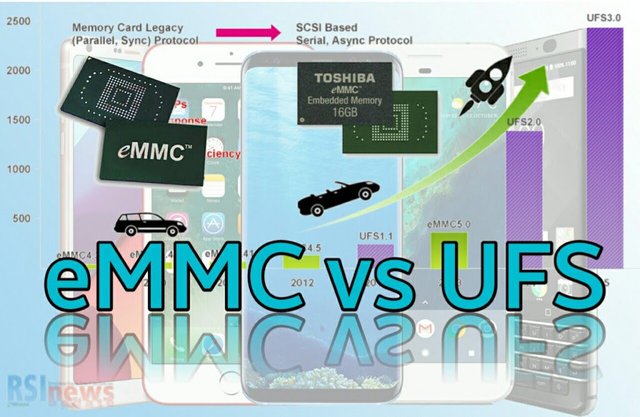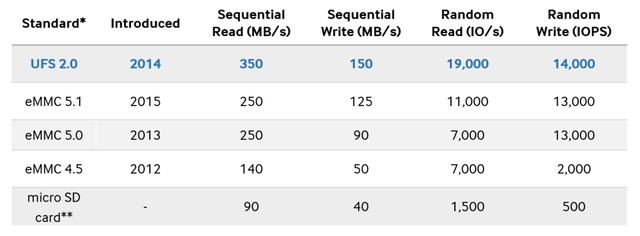EMMC VS UFS

In every smartphone there are vital components that play an important role. CPU and RAM are two pieces of hardware that have an important role to play in boosting smartphone performance.
And what is not less important is the existence of an internal memory chip that will support all the files in it such as applications, photos, music, and the operating system itself.
This chip is not as fast as RAM, but it can store information indefinitely, even when the device is turned off. Therefore, a good smartphone requires at least 32GB of storage capacity, which is the standard of some smartphone vendors today.
The speed of a smartphone is also not only driven by the speed of the CPU and RAM, but the internal memory chip in the reading and writing process also plays a big role in controlling various tasks ordered by the CPU.
Currently, a smartphone generally uses the eMMC storage system and even the latest flagship smartphones have started to adopt UFS technology. Then what is the basic difference between the two in terms of speed? Listen to this discussion thoroughly.
:: What is eMMC?
eMMC, or embedded Multi-Media Card or also embedded Multi-Media Controller, is a storage medium for NAND flash memory for mobile applications that currently dominates in several electronic devices, including tablets, smartphones, GPS systems, eReaders, and other mobile computing devices. As a controller / interface circuit to help sort processes and improve performance, eMMC 5.1 technology became the current memory standard published by JEDEC in 2015.
:: Then, What is UFS?
In the simplest terms, UFS or Universal Flash Storage is the new standard for the next generation of the fastest storage technology in the world today. The new UFS 2.1 technology is the most advanced that meets JEDEC compatibility, the world's most advanced next-generation flash memory specification, enabling a more sophisticated mobile experience for consumers. UFS 1.0 storage was announced for the first time in 2011, and 2013 brings us version 2.0 which is 4 times faster than before. In 2015, UFS introduced version 2.1 which for the first time arrived on the Samsung Galaxy S6. Currently, the latest UFS 2.1 is being used on the OnePlus 5, as well as on other high-end smartphones such as the Samsung Galaxy S8 and the HTC U11.
:: How Fast is eMMC Compared to UFS?
UFS is intended to be a replacement for eMMC, an older although still widely used storage technology. eMMC is cheaper and easier to implement, but it is much slower both in theory and practice. UFS offers substantially an increase in the proportion of high-capacity memory. There are two main factors contributing to this.
First, UFS has a separate serial interface dedicated to read and write processes based on LVDS (Low-Voltage Differential Signaling) which allows it to interact in two directions (full duplex), so that UFS can read and write simultaneously. Whereas eMMC has a parallel interface that can only send data in one direction at a time, which means it can read or write not at the same time.

Second, UFS memory uses "Command Queue (CQ)," a technology that speeds up the speed of execution of commands on SSDs via a serial interface, which significantly increases data processing speed compared to the eMMC standard based on 8-bit parallel interfaces. As a result, UFS memory is capable of performing 19,000 Input / Output Per Scond (IOPS) operations for random reading, which is 2.7 times faster than the most common embedded memory for smartphones today, eMMC 5.1. The memory is also capable of sequential reads and writes with performance boosted to an SSD equivalent, but with a 50% reduction in energy consumption.

In addition, random read speeds are 12 times faster than typical high-speed memory cards (running at 1,500 IOPS), and are expected to further improve system performance whereby devices can boot faster, offering fast response to flash storage. input / output data, three times faster file copying, and three times multitasking capabilities.
:: What Are the Practical Benefits of eMMC and UFS?
Sure, faster storage means better performance. Currently UFS memory technology supports the needs of the high-end mobile market, while eMMC is a solution for the mid-market, a segment that is tailored according to its value. For random writing of data to storage, this ultra-fast UFS memory operates at 14,000 IOPS and is 28 times faster than conventional external memory cards, so as to support smooth Ultra HD video playback and smooth multitasking functions at the same time, enabling multiple enhanced mobile experience.
In an effort to provide consumers with more design flexibility, UFS memory is becoming a new ePoP (embedded Package on Packag) solution, which can be stacked directly on top of the logic chip, taking up about 50% less space. For example, Samsung's UFS memory in 128GB, 64GB and 32GB versions, is twice the capacity of the eMMC line-up, making it the optimal memory storage solution today for high-end mobile devices.
:: That is the big difference between eMMC memory technology and UFS, which is expected to be a reference for those of you who want to buy a new smartphone. The choice is yours, whether you still choose a smartphone with eMMC memory, or the new generation of memory with multiple speeds that UFS has.
:))